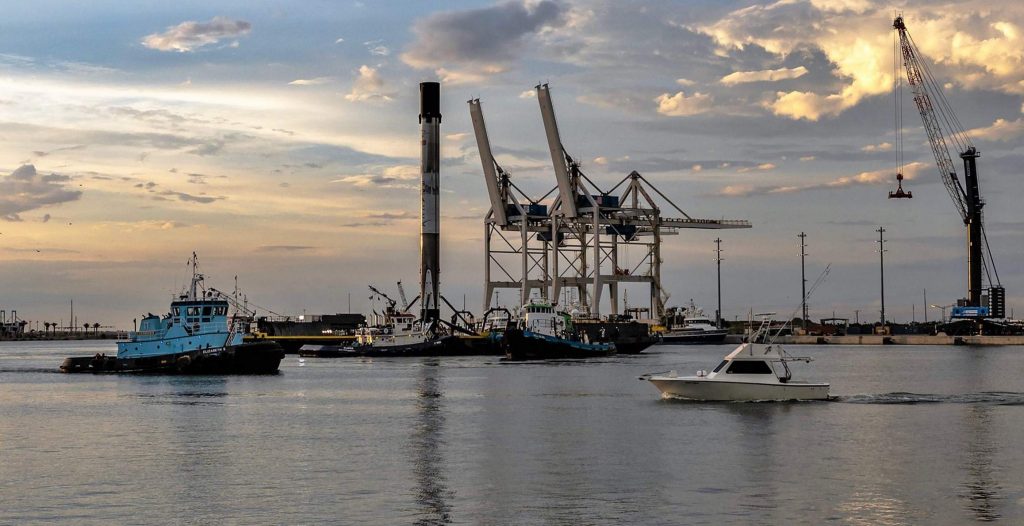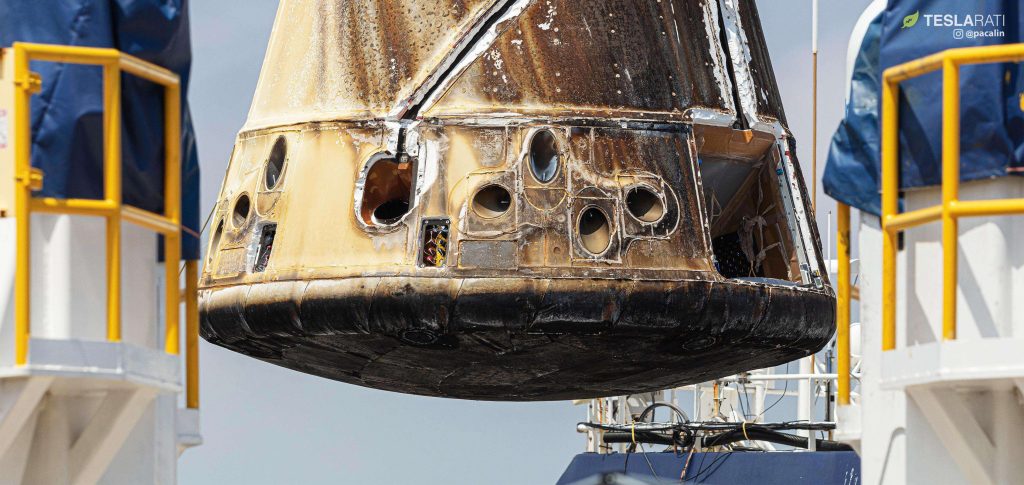

News
SpaceX Falcon 9 nears NASA’s first flight-proven Block 5 launch after static fire delays
After multiple days of delays, many a finger is crossed that SpaceX will be able to perform a critical static fire test of Falcon 9 booster B1056.1 on Friday morning (July 19th).
Falcon 9 B1056 and a fresh upper stage are scheduled to launch Cargo Dragon mission CRS-18 no earlier than 7:35 pm EDT (23:35 UTC), July 21st. As always, SpaceX requires each Falcon 9 rocket to successfully perform a static fire ignition test prior to declaring launch readiness, and B1056 was originally planned to be loaded with propellant and fire its nine Merin 1D engines on Wednesday, July 16th.
After a solid handful of slips, the test has most recently been rescheduled on Friday morning, a delay of 48 hours. SpaceX has demonstrated a three-day turnaround between static fire and launch with Falcon 9 Block 5, but a static fire delay beyond Friday – perhaps even beyond early Friday afternoon – will almost certainly push CRS-18’s launch back a day or two. If not, SpaceX is certainly cutting it close to make the current July 21st date.
In support of Cargo Dragon Commercial Resupply Mission-17 (CRS-17), Falcon 9 B1056 launched for the first time on May 4th, roughly 11 weeks (76 days) ago and 78 days before its planned return to flight. For both SpaceX and NASA, CRS-18 will be a fairly significant launch for a variety of reasons

Falcon2
First and foremost, Falcon 9 B1056 previously supported a NASA Cargo Dragon mission, as described above. Even before the booster successfully landed and returned to port, plans were already in order to essentially keep the booster “in family”, reusing it for NASA launches only. Discussed on Teslarati immediately after the subject was broached during a post-launch press conference, NASA manager Kenny Todd didn’t split hairs.
“Quite frankly, [NASA] had a vested interest in this particular booster. We were gonna require it – the intent is to [reuse B1056 on SpaceX’s upcoming CRS-18 launch] and – potentially – CRS-19.”
Kenny Todd, ISS Operations and Integration Manager, NASA Johnson
Not only will NASA fly Cargo Dragon’s CRS-18 mission on B1056, but the agency is already actively considering reusing the same Falcon 9 booster – assuming a successful launch and landing next week – on CRS-19, SpaceX’s second-to-last Dragon 1 (i.e. Cargo Dragon) launch. If all goes well with CRS-18, CRS-19 could come as early as December 2019, while CRS-20 – likely Dragon 1’s last launch ever – is scheduled no earlier than March 2020 and could certainly make use of B1056.3 if NASA is interested.
Dragon3
Meanwhile, although neither SpaceX or NASA have confirmed it, the Cargo Dragon capsule flight-proven Falcon 9 B1056 will itself be flight-proven – although that’s nothing shocking after a full half-dozen successful launches of reused capsules. What will be exceptional, however, is the likely event that CRS-18 will mark the first time that SpaceX has launched the same Cargo Dragon capsule on its third orbital mission.
Speaking all the way back in summer 2017, now two years distant, SpaceX CEO Elon Musk revealed that Cargo Dragon (Dragon 1) was designed at the outset to be reused three times. Almost exactly 24 months later, SpaceX is likely to prove that that is the case. Based on a list of known Dragon 1 capsules and their serial numbers, SpaceX has already launch and reused all but one of the last seven capsules built and successfully recovered. Capsule 107 (C107) supported CRS-5 in January 2015 and was successfully recovered one month later.

Aside from CRS-7 capsule C109, destroyed in June 2015 during Falcon 9’s first and only in-flight failure, all other capsules (C108-C113) have been successfully launched, recovered, and relaunched. As such, it seems extremely improbable that CRS-5 capsule C107 will be supporting CRS-18. Instead, one of SpaceX’s six twice-flight-proven orbital spacecraft has likely been refurbished for the final time, preparing to become the first orbital-class commercial spacecraft to be reused twice.
Thy Holy Stripe
Finally, it also appears that CRS-18 will mark the debut some sort of on-orbit Falcon upper stage test, hinted at by a grey ring wrapping what looks like just a portion of its fuel (RP-1/kerosene) tank. The objective of this modification is unclear, although chances are good that either NASASpaceflight.com or SpaceX itself will provide at least a bit more information in the coming days.
Check out Teslarati’s Marketplace! We offer Tesla accessories, including for the Tesla Cybertruck and Tesla Model 3.

Elon Musk
Elon Musk and Tesla AI Director share insights after empty driver seat Robotaxi rides
The executives’ unoccupied tests hint at the rapid progress of Tesla’s unsupervised Robotaxi efforts.

Tesla CEO Elon Musk and AI Director Ashok Elluswamy celebrated Christmas Eve by sharing personal experiences with Robotaxi vehicles that had no safety monitor or occupant in the driver’s seat. Musk described the system’s “perfect driving” around Austin, while Elluswamy posted video from the back seat, calling it “an amazing experience.”
The executives’ unoccupied tests hint at the rapid progress of Tesla’s unsupervised Robotaxi efforts.
Elon and Ashok’s firsthand Robotaxi insights
Prior to Musk and the Tesla AI Director’s posts, sightings of unmanned Teslas navigating public roads were widely shared on social media. One such vehicle was spotted in Austin, Texas, which Elon Musk acknowleged by stating that “Testing is underway with no occupants in the car.”
Based on his Christmas Eve post, Musk seemed to have tested an unmanned Tesla himself. “A Tesla with no safety monitor in the car and me sitting in the passenger seat took me all around Austin on Sunday with perfect driving,” Musk wrote in his post.
Elluswamy responded with a 2-minute video showing himself in the rear of an unmanned Tesla. The video featured the vehicle’s empty front seats, as well as its smooth handling through real-world traffic. He captioned his video with the words, “It’s an amazing experience!”
Towards Unsupervised operations
During an xAI Hackathon earlier this month, Elon Musk mentioned that Tesla owed be removing Safety Monitors from its Robotaxis in Austin in just three weeks. “Unsupervised is pretty much solved at this point. So there will be Tesla Robotaxis operating in Austin with no one in them. Not even anyone in the passenger seat in about three weeks,” he said. Musk echoed similar estimates at the 2025 Annual Shareholder Meeting and the Q3 2025 earnings call.
Considering the insights that were posted Musk and Elluswamy, it does appear that Tesla is working hard towards operating its Robotaxis with no safety monitors. This is quite impressive considering that the service was launched just earlier this year.
Elon Musk
Starlink passes 9 million active customers just weeks after hitting 8 million
The milestone highlights the accelerating growth of Starlink, which has now been adding over 20,000 new users per day.

SpaceX’s Starlink satellite internet service has continued its rapid global expansion, surpassing 9 million active customers just weeks after crossing the 8 million mark.
The milestone highlights the accelerating growth of Starlink, which has now been adding over 20,000 new users per day.
9 million customers
In a post on X, SpaceX stated that Starlink now serves over 9 million active users across 155 countries, territories, and markets. The company reached 8 million customers in early November, meaning it added roughly 1 million subscribers in under seven weeks, or about 21,275 new users on average per day.
“Starlink is connecting more than 9M active customers with high-speed internet across 155 countries, territories, and many other markets,” Starlink wrote in a post on its official X account. SpaceX President Gwynne Shotwell also celebrated the milestone on X. “A huge thank you to all of our customers and congrats to the Starlink team for such an incredible product,” she wrote.
That growth rate reflects both rising demand for broadband in underserved regions and Starlink’s expanding satellite constellation, which now includes more than 9,000 low-Earth-orbit satellites designed to deliver high-speed, low-latency internet worldwide.
Starlink’s momentum
Starlink’s momentum has been building up. SpaceX reported 4.6 million Starlink customers in December 2024, followed by 7 million by August 2025, and 8 million customers in November. Independent data also suggests Starlink usage is rising sharply, with Cloudflare reporting that global web traffic from Starlink users more than doubled in 2025, as noted in an Insider report.
Starlink’s momentum is increasingly tied to SpaceX’s broader financial outlook. Elon Musk has said the satellite network is “by far” the company’s largest revenue driver, and reports suggest SpaceX may be positioning itself for an initial public offering as soon as next year, with valuations estimated as high as $1.5 trillion. Musk has also suggested in the past that Starlink could have its own IPO in the future.
News
NVIDIA Director of Robotics: Tesla FSD v14 is the first AI to pass the “Physical Turing Test”
After testing FSD v14, Fan stated that his experience with FSD felt magical at first, but it soon started to feel like a routine.

NVIDIA Director of Robotics Jim Fan has praised Tesla’s Full Self-Driving (Supervised) v14 as the first AI to pass what he described as a “Physical Turing Test.”
After testing FSD v14, Fan stated that his experience with FSD felt magical at first, but it soon started to feel like a routine. And just like smartphones today, removing it now would “actively hurt.”
Jim Fan’s hands-on FSD v14 impressions
Fan, a leading researcher in embodied AI who is currently solving Physical AI at NVIDIA and spearheading the company’s Project GR00T initiative, noted that he actually was late to the Tesla game. He was, however, one of the first to try out FSD v14.
“I was very late to own a Tesla but among the earliest to try out FSD v14. It’s perhaps the first time I experience an AI that passes the Physical Turing Test: after a long day at work, you press a button, lay back, and couldn’t tell if a neural net or a human drove you home,” Fan wrote in a post on X.
Fan added: “Despite knowing exactly how robot learning works, I still find it magical watching the steering wheel turn by itself. First it feels surreal, next it becomes routine. Then, like the smartphone, taking it away actively hurts. This is how humanity gets rewired and glued to god-like technologies.”
The Physical Turing Test
The original Turing Test was conceived by Alan Turing in 1950, and it was aimed at determining if a machine could exhibit behavior that is equivalent to or indistinguishable from a human. By focusing on text-based conversations, the original Turing Test set a high bar for natural language processing and machine learning.
This test has been passed by today’s large language models. However, the capability to converse in a humanlike manner is a completely different challenge from performing real-world problem-solving or physical interactions. Thus, Fan introduced the Physical Turing Test, which challenges AI systems to demonstrate intelligence through physical actions.
Based on Fan’s comments, Tesla has demonstrated these intelligent physical actions with FSD v14. Elon Musk agreed with the NVIDIA executive, stating in a post on X that with FSD v14, “you can sense the sentience maturing.” Musk also praised Tesla AI, calling it the best “real-world AI” today.








